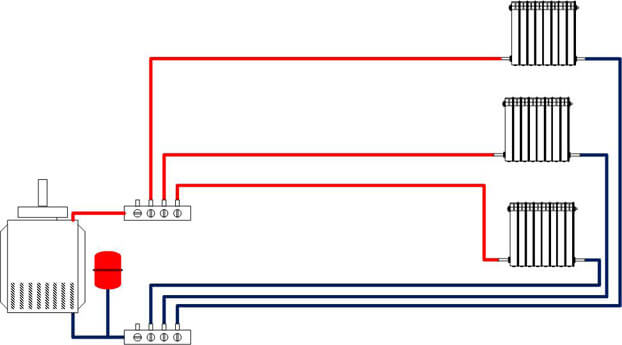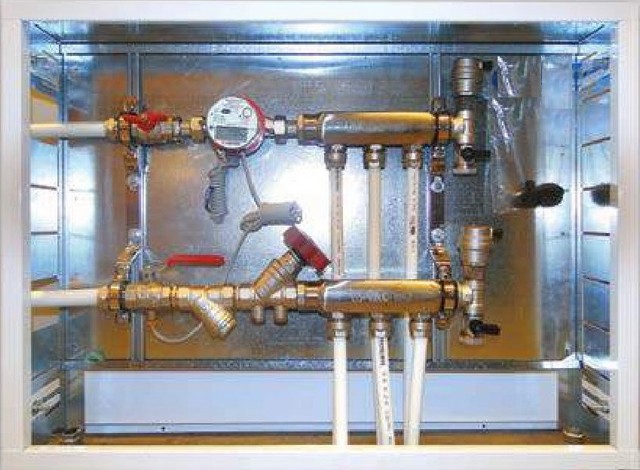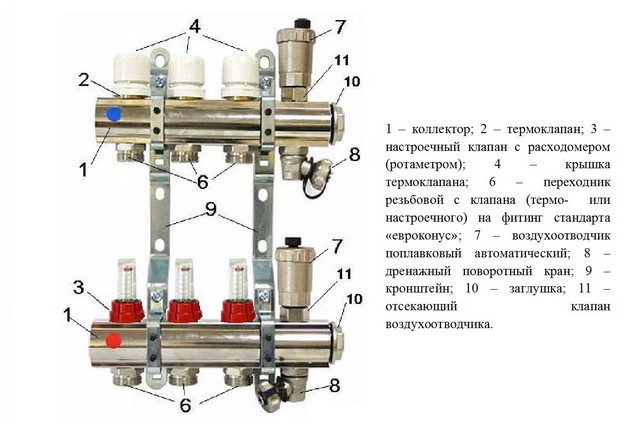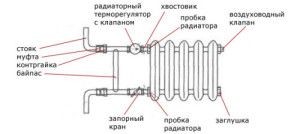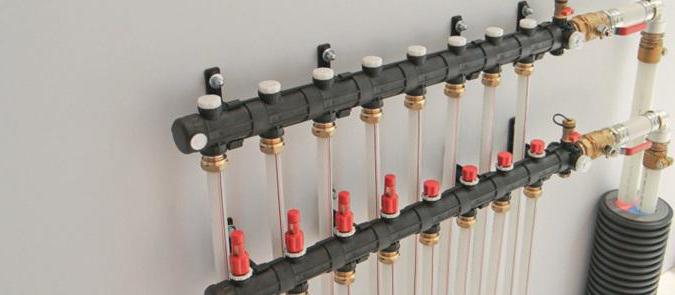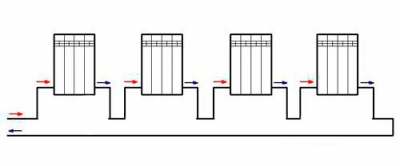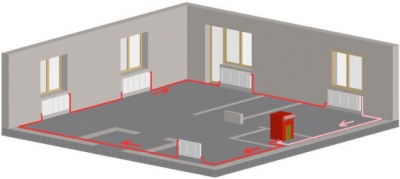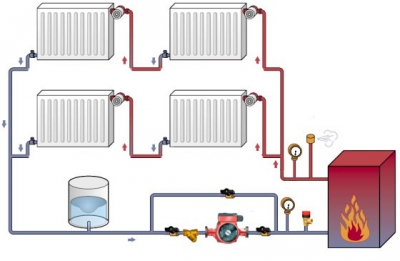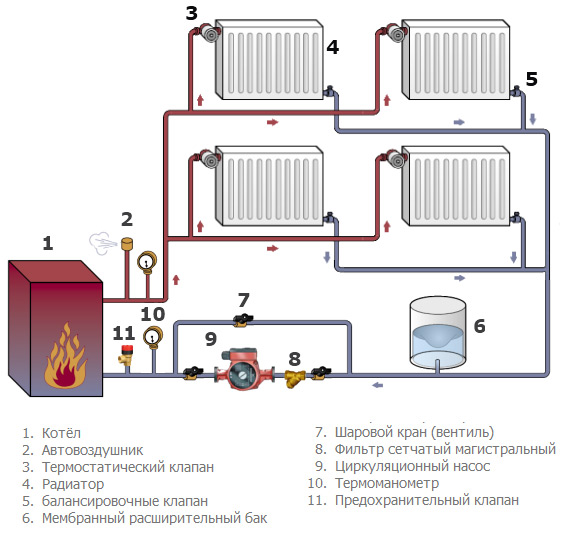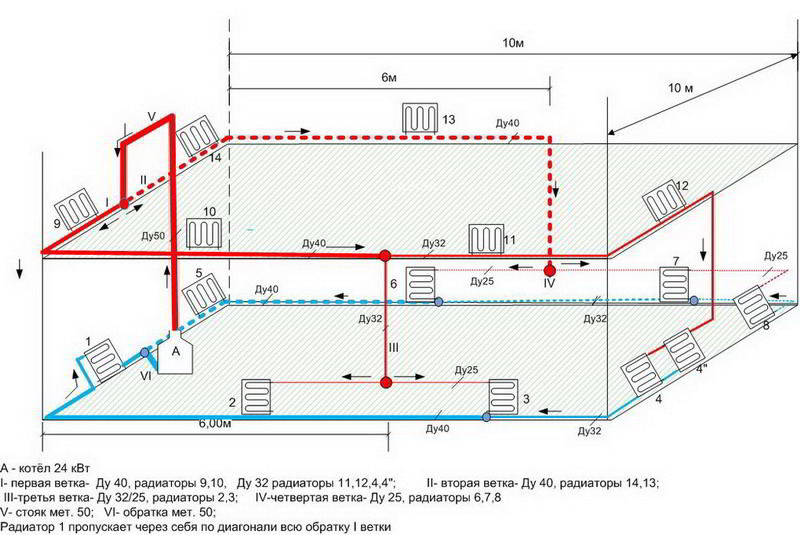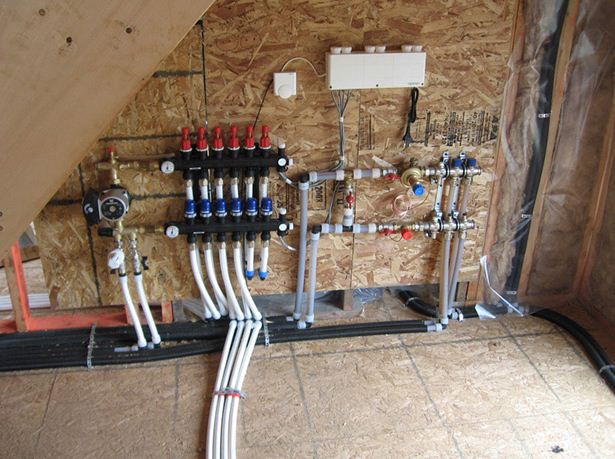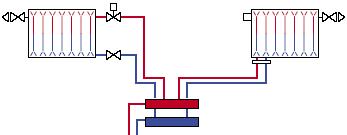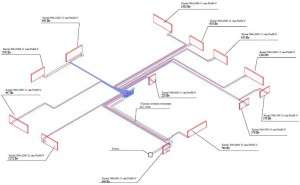Elements of the collector heating scheme
Radiant heating of a private house is a structure consisting of several main elements:
- heating boiler. This device is the starting point, since from it the hot coolant is directed to pipelines and radiators. The power of the heat unit must correspond to the heat transfer of the heating equipment. Here there is the following nuance: the beam layout of the heating system, unlike other options for piping, has a greater degree of heat loss, which must certainly be taken into account when calculating the parameters of the equipment.
- Circulation pump. According to the peculiarities of its device, the radiant heating distribution is of a closed type and its operation requires forced circulation of a liquid coolant. For this purpose, a special pump is installed that creates a certain pressure and pumps liquid. As a result, the required temperature regime is ensured, which guarantees the efficient operation of the heat supply system.
When choosing a circulation pump for radiant heating, you should pay attention to a number of parameters, including the length of the pipelines and the materials used to manufacture the radiators. In addition, the power of the pump is not one of its most important characteristics; the speed at which the liquid will be pumped should be taken into account.
This parameter shows the volume of coolant moved by the circulating device per unit of time
In addition, the power of the pump is not one of its most important characteristics; the speed at which the liquid will be pumped should be taken into account. This parameter shows the volume of coolant moved by the circulating device per unit of time.
Collector (it is also called a comb). It is also an important element of the beam wiring of the heating system. The comb is assigned the function of a switchgear designed for centralized supply of heating radiators with coolant (for more details: “The distribution comb of the heating system - purpose and principle of operation“).
The beam scheme of the heating system always contains a variety of thermostatic or shut-off and control elements. They provide the necessary consumption of the carrier of thermal energy in each branch of the structure. To create additional conditions for more efficient operation of the heating structure without unnecessary costs, the installation of thermometers and air vents operating in automatic mode will help.
Collectors in the domestic market are offered to consumers in a wide range. The choice of a specific device is based on the number of designed heating circuits or connected radiators. Combs are made from various materials - it can be brass or steel, as well as polymer products.
Cabinets. The radiant heating scheme requires that all elements included in it be located in special structures equipped for them. Distribution manifold for heating. shut-off valves, pipelines must be placed in manifold cabinets that have a simple design. They are both built into the niche of the wall, and external, but at the same time they differ in functionality and practicality.
Collector cabinets and blocks
In an apartment with horizontal radiant heating distribution (on the floors of private houses), distribution manifolds (supply and "return") are arranged, collecting all supply and return pipelines at their outlets. They are placed in metal cabinets of a special design, often built into the partitions of bathrooms and opening inside them.It is also possible to install distribution manifolds in specially arranged wall niches. Often, the collector unit is combined with the heat metering unit in one collector cabinet.
Collector cabinet with heat metering unit.
Collectors can be complete, which are sections of thick pipes with outgoing nozzles, or assembled on tees. These devices can be:
- plastic;
- nickel-plated brass;
- copper;
- stainless steel.
Many well-known manufacturers of heating equipment (VALTEC, etc.) produce ready-made manifold blocks that combine supply and return manifolds, manual adjustment valves (on the supply manifold), thermostatic valves (on the return manifold), automatic air vents, drain valves and mounting brackets.
Complete manifold block.
The task of individual adjustment of the thermal regime of each single-radiator branch of the collector-beam heating system is solved by tuning valves with built-in flow meters. The branches are obtained in different lengths, and the coolant tends to flow in the shortest way with minimal hydraulic resistance. It flows around short branches more intensively, warming up the radiators installed there more strongly.
Adjustment valves on the supply manifold change the flow rate of water (antifreeze), narrowing their conditional passages in short circuits, and expanding in long ones. Setting is a painstaking process, and the setting valve is not designed to quickly shut off or open the coolant flow along the circuits. This function is performed by thermostatic valves.
Thermal valves on the manifold - "return" - these are valves that smoothly shut off the flow manually or automatically. The radiant heating system is easily hydraulically balanced.
Features of a radiant home heating system
However, there is another point that should not be overlooked. It is a setting or regulation. It is carried out just in the regulation of the valves located on the collector. But it is worth saying that such a system is inconvenient because you have to adjust the modes all the time, which is not always possible to afford purely physically. In addition, if you have a fairly large building, then it is better to refuse this idea.
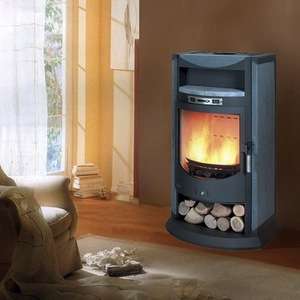
Overview of schemes and components of the heating system
At the first stage, it is necessary to choose the principle of operation of the heating system. Even 20-25 years ago, there was practically no alternative - they made a gravitational open system. Therefore, the question of how to properly install heating was reduced to choosing the diameter of steel pipes and their correct slope. But the appearance on the market of the main elements of a closed system has greatly expanded the choice of scheme.
Gravity heating system
Scheme of gravity heating
The main source of water heating for it is a solid fuel boiler (working on diesel or waste oil is possible). Installation of gas models is not possible, since their normal operation implies increased pressure in the pipes. Self-assembly of a heating system with a gas boiler is possible. But in this case, a solid fuel housing is used, in which a special gas burner is mounted.
Before you properly install heating in a private house, you need to select its main components. In addition to the boiler, the following elements are mandatory:
- Pipes. For this type of heating, you can use plastic models (polypropylene, metal-plastic) or steel. It is best to choose a large diameter - from 40 mm. In this way, the total hydraulic resistance can be reduced;
- Expansion tank. Required to stabilize the system in case of overheating of the coolant;
- Stop valve. Its installation is mandatory, since during repair or maintenance work it will be necessary to block the coolant flow in a certain section of the system;
- Drinking node. Required to add coolant. In order to optimize it, it is often included in the design of the expansion tank.
Complete set of a radiator for a single-pipe heating system
The gravity system in most cases is made single-pipe (Leningrad). In order to properly mount the heating radiator, it is necessary to install a bypass on each of them. This should also be taken into account when purchasing components and drawing up a general installation scheme.
In addition to these components, the installation of pressure gauges is necessary. If this device is not provided for in the boiler design, it should be installed on the outlet pipe.
To mount a heating radiator, it is necessary to provide for the presence of a Mayevsky crane in it. It is necessary to eliminate air jams in the system.
Scheme of a heating system with forced circulation
Closed heating scheme with a solid fuel boiler
It is much more difficult to install a forced circulation heating system. The difference lies in the creation of increased pressure in the line. This contributes to an increase in the length of pipelines and the optimal temperature regime of the entire system.
The complete set of this scheme is best considered using the example of piping a solid fuel boiler. Since for most gas models, the vast majority of the components are part of the design (circulation pump, expansion tank, etc.). Therefore, in order to mount the heating system yourself, in addition to the boiler, the system must contain:
- Circulation pump. It will create the necessary level of pressure of the coolant;
- Closed expansion tank. Serves as a compensator when the pressure in the system rises above the critical one;
- Security group. Partly duplicates the functions of the expansion tank. If the pressure indicators are too high, the air vent and drain valve will reduce it, removing excess air and coolant from the system;
- Stop valves ;
- Refill node.
How to install a closed-type heating system yourself, and most importantly - which piping scheme to choose? Experts recommend installing a two-pipe one, since the radiators in this case will be connected in parallel, which will ensure an even temperature distribution throughout the system.
Installing a forced-type heating system is much easier than with natural circulation. In addition, the first is the only option for houses with an average and large area.
Manifold selection
The radiant heating system incorporates a collector (comb). This element looks like a pipe. It has fittings for the inlet and outlet of the coolant. For a beam scheme, two types of collectors should be installed.
The first of these will be the input comb. A pump is connected to it, as well as a coolant distribution valve. It can be three- or two-way. The valve contains a thermometer. It is installed in the collector housing. The device transmits information to the valve. It opens or closes the damper, mixing hot liquid into the circuit.
The outlet collector collects the cooled coolant, which is returned to the boiler. The heater heats it up again.Additionally, a balancing flow controller can be installed on this branch pipe. The collector group ensures the stability of the system. It is responsible for optimizing and balancing the heating of the coolant in the system.
Single pipe horizontal
The simplest version of a single-pipe horizontal heating system with a bottom connection.
When creating a heating system for a private house with your own hands, a single-pipe wiring scheme can be the most profitable and cheapest. It is equally well suited for both one-story houses and two-story houses. In the case of a one-story house, it looks very simple - the radiators are connected in series - in order to ensure the consistent flow of the coolant. After the last radiator, the coolant is sent through a solid return pipe to the boiler.
Advantages and disadvantages of the scheme
To begin with, we will consider the main advantages of the scheme:
- ease of implementation;
- great option for small houses;
- saving materials.
A single-pipe horizontal heating scheme is an excellent option for small rooms with a minimum number of rooms.
The scheme is really very simple and understandable, so even a beginner can handle its implementation. It provides for a serial connection of all installed radiators. This is an ideal heating layout for a small private house. For example, if this is a one-room or two-room house, then “fencing” a more complex two-pipe system does not make much sense.
Looking at the photo of such a scheme, we can note that the return pipe here is solid, it does not pass through the radiators. Therefore, such a scheme is more economical in terms of material consumption. If you do not have extra money, such a wiring will be the most optimal for you - it will save money and allow you to provide the house with heat.
As for the shortcomings, they are few. The main disadvantage is that the last battery in the house will be colder than the very first one. This is due to the sequential passage of the coolant through the batteries, where it gives off the accumulated heat to the atmosphere. Another disadvantage of a single-pipe horizontal circuit is that if one battery fails, the entire system will have to be turned off at once.
Despite certain disadvantages, this heating scheme continues to be used in many private houses of a small area.
Features of the installation of a single-pipe horizontal system
Creating water heating of a private house with your own hands, a scheme with a single-pipe horizontal wiring will be the easiest to implement. During the installation process, it is necessary to mount the radiators, and then connect them with pipe sections. After connecting the last radiator, it is necessary to turn the system in the opposite direction - it is desirable that the outlet pipe runs along the opposite wall.
A single-pipe horizontal heating scheme can also be used in two-story houses, each floor is connected in parallel here.
The larger your home, the more windows it has and the more radiators it has. Accordingly, heat losses also increase, as a result of which it becomes noticeably cooler in the last rooms. You can compensate for the drop in temperature by increasing the number of sections on the last radiators. But it is best to mount a system with bypasses or with forced circulation of the coolant - we will talk about this a little later.
A similar heating scheme can be used to heat two-story houses. To do this, two chains of radiators are created (on the first and second floors), which are connected in parallel to each other. There is only one return pipe in this battery connection scheme; it starts from the last radiator on the first floor. A return pipe is also connected there, descending from the second floor.
Radiant heating system for a two-story house is the best choice
At the moment, a more efficient and economical floor heating system for two-story private country houses is simply not to be found than a two-pipe beam scheme. Having correctly selected the equipment, as well as having calculated all the nuances and having completed the installation, as required by the instructions, you can ensure comfort and coziness in the house.
It is important to point out the fact that traditional radiators are the main heating devices in a double-circuit beam system. Regardless of the size and material (and it can be either cast iron or aluminum), such units must be correctly installed:
Regardless of the size and material (and it can be either cast iron or aluminum), such units must be correctly installed:
- Heating batteries must be mounted only under window openings;
- All heating radiators must be mounted at the same height;
- The fins of the battery are located only vertically - otherwise the normal circulation of the coolant will be impossible;
- It is imperative to provide a drain system through which the coolant will be replaced.
Two-pipe heating system for a house with two floors
A boiler also means a lot (see how to choose a gas heating boiler)
For the normal operation of a two-circuit system, it is important to choose modern and efficient boilers. Such equipment (and even equipped with automation) will make it possible to ensure optimal heating of each room of a two-story house, significantly saving fuel and finances and getting hot water
The heating system of a two-story building of a two-pipe radiant heating scheme is not only quite productive and efficient, but also demanding for the first start.
So, for example, before starting direct operation, it is important to correctly balance the system, adjust the fluid flow for each loop of supply and return pipelines. This is the only way to save fuel, ensure the highest possible level of heating
Modern heating systems

Heating systems, first of all, are divided according to how the pipes are connected from the collector to the radiators. These are several types of systems such as;
- Single pipe;
- Two-pipe;
- Radiation;
The principle of radiant heating is that the wiring from the collector, the main distributor of the coolant, is meant for each radiator separately. This is the most significant plus in this system - radiators can be turned on and off, both individually and as a group.
In addition, the heat supply valve can be adjusted. For example, if the kitchen does not require such an amount of thermal radiation, due to the operation of household appliances that serve as an additional source of heat, then the valve can be screwed on. This can be done in such a way that heat enters the kitchen, but not in the same quantity as in other rooms. The same can be done with those rooms that are not used for their intended purpose, but they must be kept warm. By regulating the heat supply, fuel economy also increases. and due to this, the readings of the heat meter are also pleasing.
How is a multi-storey building heated?
- The principle of operation of the elevator unit
- About the heating system of a multi-storey building
The heating system of a multi-storey building is of particular interest; it can be considered using the example of a standard five-story building.It is necessary to find out how heating and hot water supply functions in such a house.
Heating scheme for a two-story house.
The five-story house implies central heating. the house has a heating main input, there are water valves, there may be several heating units.
In most homes, the heating unit is locked, which is done to achieve security. Despite the fact that all this may seem very complicated, the heating system can be described in accessible words. The easiest way is to take a five-story building as an example.
The house heating scheme is as follows. Mud collectors are located after the water valves (there can be one mud collector). If the heating system is open, then after the mud collectors, through the tie-ins, there are valves that stand from processing and supply. The heating system is made in such a way that water, depending on the circumstances, could not be taken from the back of the house or from the supply. The thing is that the central heating system of an apartment building operates on water that is overheated, the water is supplied from the boiler house or from the CHP, its pressure is from 6 to 10 Kgf, and the water temperature reaches 1500 ° C. Water is in a liquid state even in very cold weather due to increased pressure, so it does not boil in the pipeline to form steam.
When the temperature is so high, the DHW is turned on from the back of the building, where the water temperature does not exceed 700 ° C. If the coolant temperature is low (this happens in spring and autumn), then this temperature cannot be sufficient for the normal functioning of the hot water supply, then the water for the hot water supply comes from the supply to the building.
Now you can disassemble the open heating system of such a house (this is called an open water intake), this scheme is one of the most common.
Types of radiant heating system
A visual diagram of the heating system in a private house.
The radiant heating system in a private house can be installed with both forced and natural circulation of the heat carrier. At present, a system with natural circulation is used very rarely, since it requires the use of pipes with a very large diameter, which is not very convenient for a private house. In addition, this system is equipped with an expansion tank, the installation of which is necessary at the highest point of a two-story house, which again is not very convenient. But at the same time, a radiant heating system with natural circulation will help save on installation, as it will not require additional expensive equipment (pumps, temperature sensors, air vents, etc.).
The collector heating system with forced circulation is used most widely, its main advantage is the artificial circulation of heat through pipes. For these purposes, a special pump is installed in the supply or return line. Forced circulation makes it possible to reduce the temperature difference between the inlet and outlet water, and also simplifies the heating system itself, which makes it more compact and helps to avoid unnecessary consumption of materials. This heating system is absolutely independent of the design of the house and the location of the heated rooms in it. The hydraulic resistance of the pipeline and the length of the branches do not play a special role. And due to the installation of modern automatic devices, it is possible to change the temperature depending on the weather conditions and the individual wishes of the residents. All these advantages make this system universal.
The choice of pipes for the heating system
The most common for the installation of heating systems in two-story houses are metal-plastic pipes. This is primarily due to the fact that deposits are not deposited on products made of polymeric materials and they are resistant to corrosion.The rather low price is another advantage of metal-plastic pipes. All connections are made without the use of welding using threaded or press connections, which simplifies installation as much as possible. Nevertheless, such pipes have one drawback - a high coefficient of thermal expansion, which, if used improperly, can lead to leaks.
Pros and cons of a radiant heating system
The disadvantages of radiant heating in the house include:
- a large number of materials and, as a result, a higher cost;
- the need for a special place for the collector block.
The advantages of the beam system are:
ease of installation due to the small number of connecting elements;
hidden laying of pipes in the floor;
hydraulic stability, which is especially important when using imported plumbing;
the ability to turn off each radiator individually, while all the others work in normal mode;
temperature control in each separate room;
balance of the system, all rooms are heated evenly.
When developing a project for a radiant heating system, it is necessary to detail it as much as possible, this will greatly simplify installation and help avoid problems in the future. It should also be noted that the actual costs will always exceed the planned ones, this must be taken into account when drawing up the estimate. But, in spite of everything, the radiant heating system is highly efficient and is able to create maximum comfort in a residential area.
Varieties of beam wiring
Method 1. With forced water circulation
Previously, a beam heating scheme equipped with pumps that pump water was not very popular due to the high cost of parts. But at present, the price of equipment has dropped significantly, and an increasing number of people are opting for it.
The main difference from the gravitational scheme is that the liquid (water or antifreeze) flows from the boiler to the batteries and back not due to the difference in temperature and pressure, but with the help of pumps.
This results in the following benefits:
- there is no restriction on the geometry and number of rooms in housing construction;
- heating can be installed in any area of the premises;
- to connect radiators and collectors, you can use pipes of any length, laid without a slope.
One of the elements of a forced circulation radiant heating system is a pump
Advice! Despite the fact that the circulation pump can be installed anywhere in the system, it is advisable to do this on the return manifold before the coolant is supplied to the boiler. There, the liquid temperature is the lowest, which has a positive effect on the service life of the equipment.
Method 2. With natural water circulation
In this case, the coolant moves due to gravity: the heated water becomes less dense and lighter, therefore it is forced out to the upper point of the system, after which, as it cools, it flows through the collectors and radiators, and then returns to the heater.
Gravitational beam heating system has the following features:
- During installation, an open expansion tank is required, installed at the highest point. It compensates for the thermal expansion of the coolant and prevents an increase in internal pressure in pipelines.
- A radiant heating network with natural circulation does not require the installation of expensive electrical equipment, which significantly reduces the estimated cost of work.
- Heating with natural circulation is completely non-volatile. Even with a power outage, which often happens in summer cottages or in rural areas, you will not be left without heat.
Gravity heating system does not use pumps
Beam wiring features and elements
The most optimal heating system with the help of radiant radiation is suitable specifically for apartment buildings, or private houses with more than one floor and many rooms. This significantly increases the efficiency of all equipment as a whole, guarantees high-quality heat supply and significantly reduces the amount of heat and energy indicators.
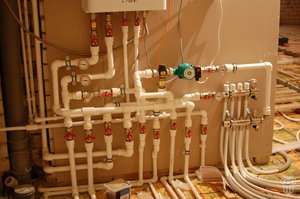
But in itself, a radiant heating system is a complex structure. combining the basic and additional elements necessary for high-quality work. This can include;
- Boiler. which is almost the main element. It is from him that heat is supplied to the pipes, and through the pipes to the radiators.
- Circular pump. which creates a certain pressure in the pipes, with the help of which the coolant circulates, and an optimally comfortable temperature in the premises is maintained. It also guarantees the efficient operation of the entire heating system;
- The collector (or, in other words, a comb), is another most important element in a radiant heating system. It is, as it were, the center, and it is from it that the uniform supply and distribution of heat to all rooms of the house comes;
- Closet. where all elements of the heating wiring must be hidden. The manifold cabinet hides the distribution manifold itself. pipes and valves. It is a rather simple design, but very functional and practical. Can be located both outside and built into the wall;
What is the difference between tee wiring and beam wiring
Such installation is quite complicated, which increases the risk of breakdowns in case of installation errors or sudden pressure drops in the heating system.
Beam wiring diagram
Radiation heating distribution involves laying pipes from each radiator to a special switchgear - a collector or, as it is also called, a comb. Naturally, here the consumption of pipes increases significantly. In addition to pipes, each radiator will need its own shutoff valves - valves, thermostats, tees and other small parts, some of which must be installed on both pipes - supply and return.
But, despite the high consumption of components, such a system makes it possible in the event of an emergency to quickly turn off any radiator, group, separate room or entire floor. The heating system can continue to operate and heat the rooms during this time.
In addition, with radial wiring, pipes are usually hidden under the floor covering, regardless of its material.
This gives an additional chance to make the floor warm, which is so important in homes where the basement is not insulated. One-piece pipe, without joints, made of cross-linked polyethylene and laid under the floor, eliminates the risk of leaks, and all repairs, if required, are carried out directly at the radiator connections or in the manifold
Natural and forced circulation of the coolant with beam wiring - which is better
Heating of any building can be carried out by natural circulation of the coolant or forced.The radiant heating system of a two-story house may well function in both cases.
Natural and forced circulation of the coolant with beam wiring
With the natural circulation of the coolant, the operation of the heating system is, of course, easier and cheaper. No need to purchase a circulation pump, various sensors, thermostats and more. Such a system is well suited if there is a long construction and the building does not have a connection to a centralized power grid or for a country house, if the residence in it is not permanent.
But on the other hand, a natural circulation heating system involves the installation of large diameter pipes and the installation of the necessary slope when laying them. As well as the installation of an expansion tank, which should be located at the highest point of the building, this is usually done in the attic. And since the attic is not always insulated, it becomes necessary to insulate the tank itself in winter and constantly monitor the state of the coolant in it.
Radiant heating at home with forced circulation of the coolant is gaining more and more fans. If in the recent past such a system was a curiosity for an ordinary consumer, now circulation pumps are installed quite often in houses, motivating this by the fact that such equipment allows you to increase the temperature in the house while reducing the financial cost of energy. And indeed it is.
Many have encountered such an effect when the supply pipe has a sufficiently high temperature, and the return pipe is slightly warm, and as a result, the house is rather cool. When installing a circulation pump, the temperature of both pipes is made the same, which gives an increase in the overall temperature in the room at the same cost of gas, wood or electricity, and possibly less. In this case, the pump can be installed on any pipe - on the supply or return. Its function is to quickly advance under a certain pressure of the coolant, as a result of which the formation of air pockets is excluded, and all heating devices are heated evenly.
